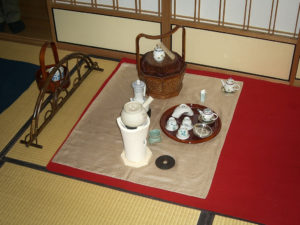
Senchadō (煎茶道) means “the way of sencha”, and it involves the preparation of loose leaf tea such as sencha and gyokuro.
Sadō, or chanoyu, which we know as the Japanese tea ceremony, uses matcha. It is much more widely known that senchadō.
The difference between the two isn’t just about the type of tea prepared, as we’ll see next.
History of Senchadō
At first, loose leaf tea drinking wasn’t common in Japan. It was mostly ground up into a powder, just like how it was introduced to Japan from China.
But on the 15th century the Chinese pan fried green tea processing method made its way into Kyushu island.
Even now, kamairicha is still produced in Kyushu, although not in very high quantities.
One important person in the history of senchadō is Ingen Ryūki (隠元隆琦, Yinyuan Longqi), a Chinese monk who came to Japan and founded the Ōbaku school of Zen in the 17th century.
In 1661 he established Mampuku temple in Uji, Kyoto prefecture.
By that time, the Japanese tea ceremony was widely practiced. For example, the famous tea master Sen no Rikyū lived at the end of the 16th century.
Ingen taught the Japanese monks about how loose leaf tea was prepared and drunk in China at the time. He also brought Chinese teaware.
Later on in the 18th century, the famous monk Baisao, which was an indirect pupil of Ingen, popularized loose leaf tea drinking.
Baisao was a respected poet, and as such he knew many of the top artists of the time.
Slowly but surely, the fashion of loose leaf tea drinking grew. Its adepts preferred this casual way of drinking tea because sadō was seen as too strict and rigid.
Nagatani Soen had developed sencha in 1738. Until then, the term sencha meant that the tea leaves were prepared in boiling water, but after Soen it became a type of green tea.
And thus sencha became so popular than even now it is drunk much more frequently than matcha.
By the end of the Edo period, there were different schools of senchadō.
About Senchadō
In general, in senchadō there are two infusions of tea prepared, and sweets are given with each one.
The utensils are different than those used in sadō, and they also vary depending on the school of senchadō. Chinese and Japanese teapots are used.
Conversation is allowed in senchadō, while silence is required in sadō.
I searched online for the best video to share with you. It’s from the Ogasawaryu school.
It’s in Japanese, but just by watching you can see how the ceremony is conducted.

June 8, 2018
Very interesting as always Ricardo. Senchado looks very refined.
June 8, 2018
Hi Andrew.
It does look very beautiful, I would love to have that set of tea utensils.